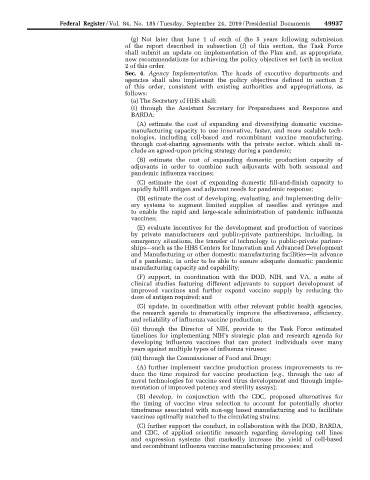Page 915 - Trump Executive Orders 2017-2021
P. 915
Federal Register / Vol. 84, No. 185 / Tuesday, September 24, 2019 / Presidential Documents 49937
(g) Not later than June 1 of each of the 5 years following submission
of the report described in subsection (f) of this section, the Task Force
shall submit an update on implementation of the Plan and, as appropriate,
new recommendations for achieving the policy objectives set forth in section
2 of this order.
Sec. 4. Agency Implementation. The heads of executive departments and
agencies shall also implement the policy objectives defined in section 2
of this order, consistent with existing authorities and appropriations, as
follows:
(a) The Secretary of HHS shall:
(i) through the Assistant Secretary for Preparedness and Response and
BARDA:
(A) estimate the cost of expanding and diversifying domestic vaccine-
manufacturing capacity to use innovative, faster, and more scalable tech-
nologies, including cell-based and recombinant vaccine manufacturing,
through cost-sharing agreements with the private sector, which shall in-
clude an agreed-upon pricing strategy during a pandemic;
(B) estimate the cost of expanding domestic production capacity of
adjuvants in order to combine such adjuvants with both seasonal and
pandemic influenza vaccines;
(C) estimate the cost of expanding domestic fill-and-finish capacity to
rapidly fulfill antigen and adjuvant needs for pandemic response;
(D) estimate the cost of developing, evaluating, and implementing deliv-
ery systems to augment limited supplies of needles and syringes and
to enable the rapid and large-scale administration of pandemic influenza
vaccines;
(E) evaluate incentives for the development and production of vaccines
by private manufacturers and public-private partnerships, including, in
emergency situations, the transfer of technology to public-private partner-
ships—such as the HHS Centers for Innovation and Advanced Development
and Manufacturing or other domestic manufacturing facilities—in advance
of a pandemic, in order to be able to ensure adequate domestic pandemic
manufacturing capacity and capability;
(F) support, in coordination with the DOD, NIH, and VA, a suite of
clinical studies featuring different adjuvants to support development of
improved vaccines and further expand vaccine supply by reducing the
dose of antigen required; and
(G) update, in coordination with other relevant public health agencies,
the research agenda to dramatically improve the effectiveness, efficiency,
and reliability of influenza vaccine production;
(ii) through the Director of NIH, provide to the Task Force estimated
timelines for implementing NIH’s strategic plan and research agenda for
developing influenza vaccines that can protect individuals over many
years against multiple types of influenza viruses;
(iii) through the Commissioner of Food and Drugs:
(A) further implement vaccine production process improvements to re-
duce the time required for vaccine production (e.g., through the use of
novel technologies for vaccine seed virus development and through imple-
mentation of improved potency and sterility assays);
(B) develop, in conjunction with the CDC, proposed alternatives for
khammond on DSKJM1Z7X2PROD with PRESDOC VerDate Sep<11>2014 15:36 Sep 23, 2019 Jkt 247001 PO 00000 Frm 00003 Fmt 4705 Sfmt 4790 E:\FR\FM\24SEE0.SGM 24SEE0
the timing of vaccine virus selection to account for potentially shorter
timeframes associated with non-egg based manufacturing and to facilitate
vaccines optimally matched to the circulating strains;
(C) further support the conduct, in collaboration with the DOD, BARDA,
and CDC, of applied scientific research regarding developing cell lines
and expression systems that markedly increase the yield of cell-based
and recombinant influenza vaccine manufacturing processes; and

